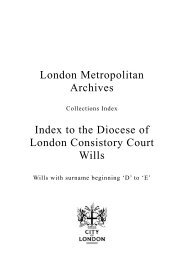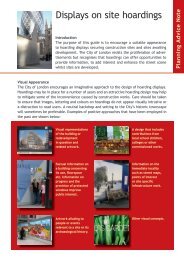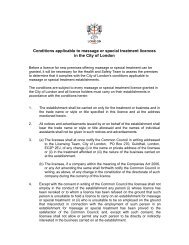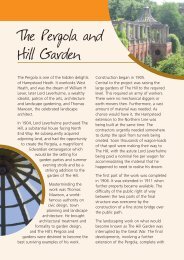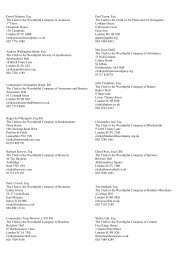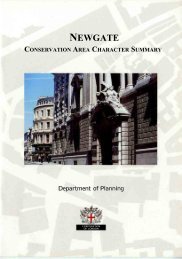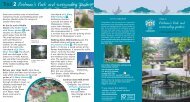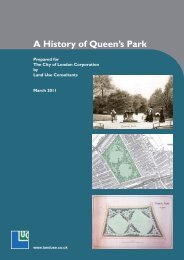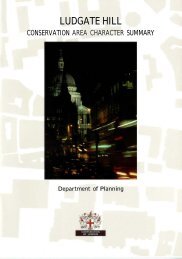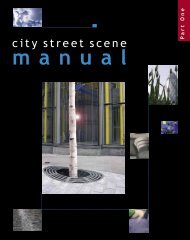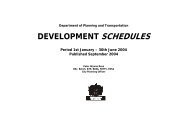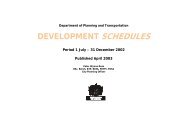Burnham Beeches Management Plan 2010 - the City of London ...
Burnham Beeches Management Plan 2010 - the City of London ...
Burnham Beeches Management Plan 2010 - the City of London ...
You also want an ePaper? Increase the reach of your titles
YUMPU automatically turns print PDFs into web optimized ePapers that Google loves.
4 objectives & Methodology - Conservation<br />
4.1.3 Heathland & Mire<br />
What Do You Like Most?<br />
The sou<strong>the</strong>rn part <strong>of</strong> <strong>Burnham</strong> “Love <strong>the</strong> duckboards<br />
<strong>Beeches</strong> was formerly an open over <strong>the</strong> mire”<br />
landscape, maintained by 2009 public consultation<br />
grazing livestock, but lack <strong>of</strong> grazing over recent<br />
decades has resulted in growth <strong>of</strong> secondary woodland<br />
over most <strong>of</strong> it. A series <strong>of</strong> projects over <strong>the</strong> last 25<br />
years has demonstrated that restoration is possible but<br />
that ongoing management is needed to restore and<br />
<strong>the</strong>n to maintain it in good condition. Birch seedlings<br />
and bracken in particular need regular attention.<br />
The legacy <strong>of</strong> several small scale clearances is a series <strong>of</strong><br />
small woodland belts that break up <strong>the</strong> area; <strong>the</strong>se<br />
need to be removed to restore <strong>the</strong> overall feel and to<br />
make ongoing management easier. In addition it is<br />
desirable to extend <strong>the</strong> open habitats so that previously<br />
cleared/thinned areas near <strong>the</strong> Stag and <strong>the</strong> Juniper<br />
Heath areas are linked.<br />
Extending <strong>the</strong> heathland habitat to <strong>the</strong> roadside areas<br />
increases <strong>the</strong> extent <strong>of</strong> this important habitat and will<br />
allow easier management <strong>of</strong> tree safety work. It will be<br />
a refuge for visitors walking around <strong>the</strong> road that feels<br />
open and safe with good visibility on ei<strong>the</strong>r side and<br />
create a view <strong>of</strong> <strong>the</strong> reserve from outside, increasing<br />
<strong>the</strong> sense <strong>of</strong> experiencing somewhere special.<br />
Maintaining a diversity <strong>of</strong> habitat including all<br />
successional areas may require scrapes and hollows to<br />
be made by hand at intervals. Scrub is a valued habitat<br />
for many species <strong>of</strong> bird, mammal and invertebrate but<br />
should be encouraged largely along <strong>the</strong> edges <strong>of</strong> <strong>the</strong><br />
open areas. It will need regular cutting to keep it at an<br />
ideal height.<br />
Guidelines for work (heathland/mire restoration and maintenance)<br />
It is anticipated that <strong>the</strong> work will require a mixture <strong>of</strong> different methods. Some can be<br />
carried out with staff/volunteers while o<strong>the</strong>rs may require large machinery. Tree felling and<br />
major mechanical work should be carried out between <strong>the</strong> end <strong>of</strong> October and <strong>the</strong> end <strong>of</strong><br />
February with <strong>the</strong> following exceptions:<br />
s Bracken control should be carried out in July/August after a check <strong>of</strong> <strong>the</strong> area for<br />
late ground nesting birds.<br />
s Weed wiping should be done in June when it is most effective but great care<br />
should be taken to avoid ground nesting birds. To minimise <strong>the</strong> risk to reptiles it<br />
should be done on a hot day (so <strong>the</strong>y can quickly move away).<br />
s Manual clearance <strong>of</strong> young, regenerating birch can be carried out in midsummer<br />
(August) as long as care is taken to avoid any nesting birds with second broods.<br />
All blocks <strong>of</strong> trees to be surveyed for bat roosts before clearance work, following <strong>the</strong> bat<br />
policy protocols. Surveys for reptile hibernation and egg sites should be carried out in<br />
clearance areas <strong>the</strong> year before works are undertaken.<br />
Some trees should be retained: <strong>the</strong>se should ideally be fruiting and flowering trees such as<br />
rowan, whitebeam and hawthorn, or occasional large oaks. Willow and aspen are valuable<br />
for wildlife and some must be kept. Regrowth from stools and suckers are readily browsed<br />
and may need protection such as dead hedging for 2 -3 years. Some dead wood should be<br />
also be retained, ideally stacked so not to hinder any future work. Stumps <strong>of</strong> deciduous<br />
trees should be treated with herbicide or removed by grinding.<br />
28



